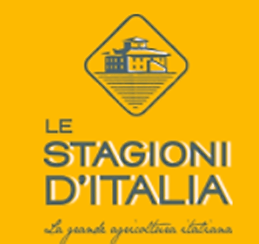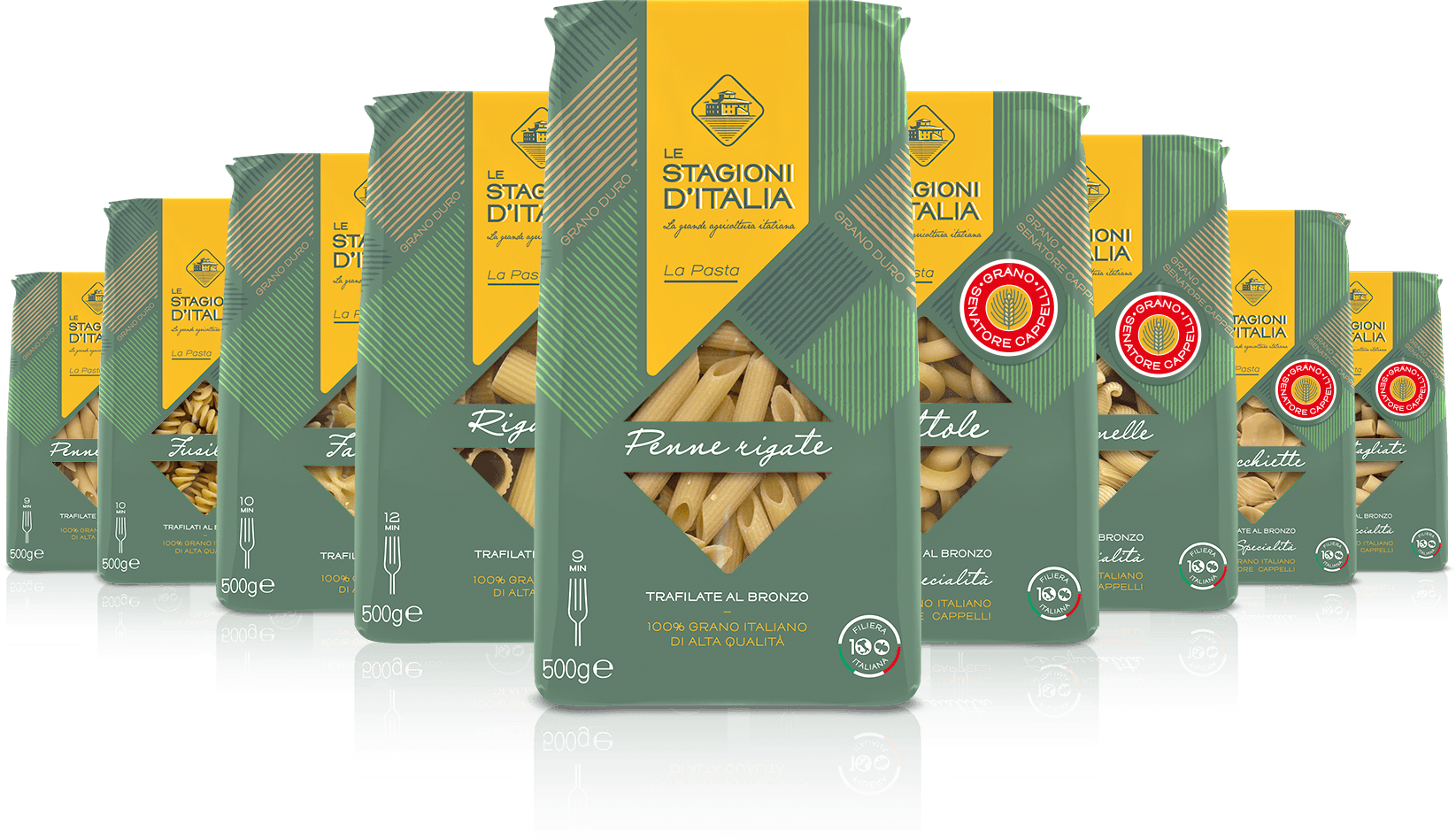The new line of products created by Bonifiche Ferraresi with 100% Italian raw materials was presented at Cibus 2018. Pasta and rice branded by “Stagioni d’Italia” are already on the GDO shelves. Within the end of the year herbal teas, flour, cereals and legumes will also be added. In less than 25 months Bonifiche Ferraresi has completed the process of vertical organization, from seed to store shelf.
The Great Italian Agriculture Is Back In Spotlight
 In just 25 months, Bonifiche Ferraresi has reinvented itself: from being the largest Italian agricultural company to becoming a real agro-industrial group. The new product line “Stagioni d’Italia” is the missing piece to complete the industrial plan, launched by the CEO Federico Vecchioni, and to make Bonifiche Ferraresi Spa the noteworthy Italian player in the agri-food sector, gaining a prominent position into the European market. This transformation is based on the vertical organization concept, through the supervision of the entire agricultural supply chain and made possible with the birth of BF Spa, listed on the Milan stock exchange and shareholder of Bonifiche Ferraresi. Bonifiche Ferraresi Spa is also the shareholder of S.I.S. – Società Italiana Sementi, leader in the autochthonous seed production -, of the Zorzi brand – branch of the company Suba Alimentare S.r.l., specialized in the packaging and marketing of seeds, cereals and legumes. “For Bonifiche Ferraresi is important the principle for which the great Italian agriculture is back in spotlight and Stagioni d’Italia products are the proof. – stated Federico Vecchioni, CEO of BF Spa – Stagioni d’Italia products born and grow on our about 7000 hectares in Italy thanks to best practices of the Italian agricultural tradition combined with the most modern and innovative precision farming techniques that allow us to place on the market products fully tracked and guaranteed by BF Spa. This is essential both to build a trust relationship with consumer, thanks to a packaging that communicates all the necessary information, and with the GDO more and more attentive to these aspects “.
In just 25 months, Bonifiche Ferraresi has reinvented itself: from being the largest Italian agricultural company to becoming a real agro-industrial group. The new product line “Stagioni d’Italia” is the missing piece to complete the industrial plan, launched by the CEO Federico Vecchioni, and to make Bonifiche Ferraresi Spa the noteworthy Italian player in the agri-food sector, gaining a prominent position into the European market. This transformation is based on the vertical organization concept, through the supervision of the entire agricultural supply chain and made possible with the birth of BF Spa, listed on the Milan stock exchange and shareholder of Bonifiche Ferraresi. Bonifiche Ferraresi Spa is also the shareholder of S.I.S. – Società Italiana Sementi, leader in the autochthonous seed production -, of the Zorzi brand – branch of the company Suba Alimentare S.r.l., specialized in the packaging and marketing of seeds, cereals and legumes. “For Bonifiche Ferraresi is important the principle for which the great Italian agriculture is back in spotlight and Stagioni d’Italia products are the proof. – stated Federico Vecchioni, CEO of BF Spa – Stagioni d’Italia products born and grow on our about 7000 hectares in Italy thanks to best practices of the Italian agricultural tradition combined with the most modern and innovative precision farming techniques that allow us to place on the market products fully tracked and guaranteed by BF Spa. This is essential both to build a trust relationship with consumer, thanks to a packaging that communicates all the necessary information, and with the GDO more and more attentive to these aspects “.
How the “Stagioni d’Italia” Brand Born
 The journalist and TV presenter Edoardo Raspelli, during an interview at the Coldiretti stand, asked Federico Vecchioni how the idea of the brand was born: “We wanted to satisfy the consumer according to his needs, that is productions that respect the times of nature during the year, at that time of cultivation and of that typical Italian productive area. So, the Stagioni d’Italia brand includes the seasonality, quality, attention to production transparency that the consumer requires, but also includes the natural and biological production cycle that is inherent in the production sites of Bonifiche Ferraresi, of the different regional realities”. With this line of products, Bonifiche Ferraresi provides the consumer a product with a 100% Italian raw material of absolute and certified quality. A quality that is expressed also through the packaging of the products, distinguished by the colors that refer to the fields with the furrows of plowing, and by its brand that is characterized by the presence of a Leopoldina (see the previous post http://www.ai-lati.eu/2018/03/12/more-value-to-valdichiana-territory/ ). Pasta is obtained starting from the wheat grown on the land of Bonifiche Ferraresi, which is transformed with the traditional bronze drawing and dried in a long time to keep intact all the qualities. Moreover, in 10 of the 20 references, Bonifiche Ferraresi uses the “Senatore Cappelli”, a fine ancient wheat variety that, thanks to its long history, has never undergone alterations or manipulations. Likewise, Rice is a totally zero km, in fact it’s directly harvested from rice fields located near the the modern rice mill of Jolanda di Savoia (FE), the Group’s headquarters, where it’s processed. It’s a rice that starts from the Italian rice tradition and that is why the range consists of varieties such as Arborio, Carnaroli, Baldo, Vialone Nano and a Well-being Line (mix of 3 cereals – rice, spelled, barley- and wholewheat).
The journalist and TV presenter Edoardo Raspelli, during an interview at the Coldiretti stand, asked Federico Vecchioni how the idea of the brand was born: “We wanted to satisfy the consumer according to his needs, that is productions that respect the times of nature during the year, at that time of cultivation and of that typical Italian productive area. So, the Stagioni d’Italia brand includes the seasonality, quality, attention to production transparency that the consumer requires, but also includes the natural and biological production cycle that is inherent in the production sites of Bonifiche Ferraresi, of the different regional realities”. With this line of products, Bonifiche Ferraresi provides the consumer a product with a 100% Italian raw material of absolute and certified quality. A quality that is expressed also through the packaging of the products, distinguished by the colors that refer to the fields with the furrows of plowing, and by its brand that is characterized by the presence of a Leopoldina (see the previous post http://www.ai-lati.eu/2018/03/12/more-value-to-valdichiana-territory/ ). Pasta is obtained starting from the wheat grown on the land of Bonifiche Ferraresi, which is transformed with the traditional bronze drawing and dried in a long time to keep intact all the qualities. Moreover, in 10 of the 20 references, Bonifiche Ferraresi uses the “Senatore Cappelli”, a fine ancient wheat variety that, thanks to its long history, has never undergone alterations or manipulations. Likewise, Rice is a totally zero km, in fact it’s directly harvested from rice fields located near the the modern rice mill of Jolanda di Savoia (FE), the Group’s headquarters, where it’s processed. It’s a rice that starts from the Italian rice tradition and that is why the range consists of varieties such as Arborio, Carnaroli, Baldo, Vialone Nano and a Well-being Line (mix of 3 cereals – rice, spelled, barley- and wholewheat).

